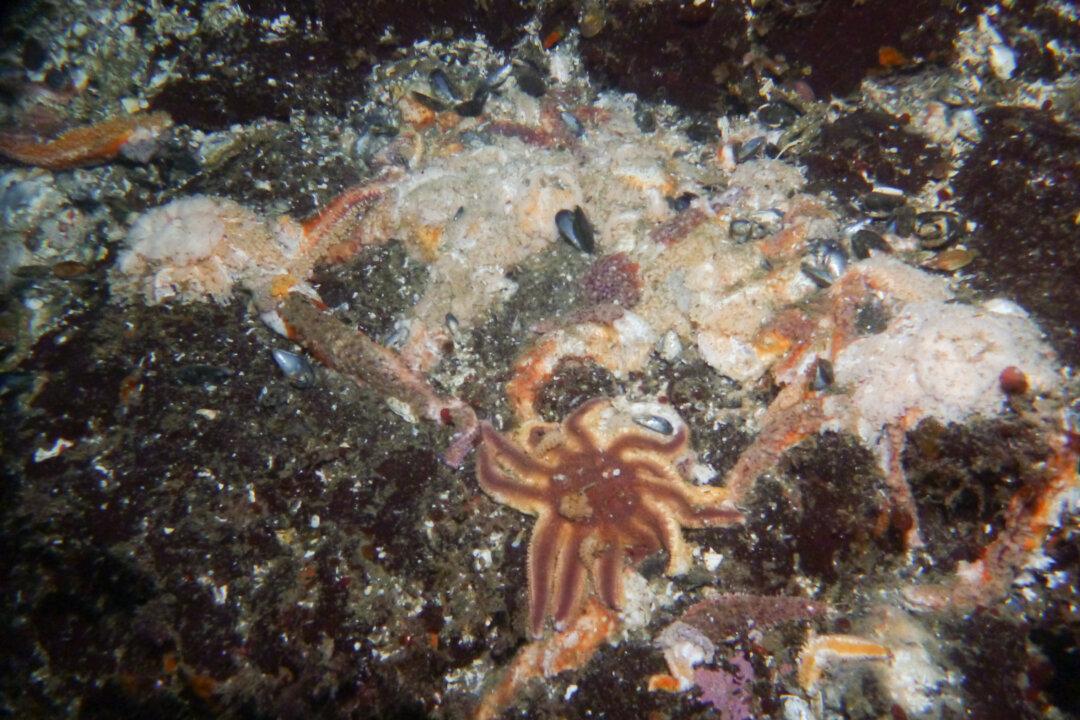Scientists don’t need dissection to know that a sea star die-off is going on, in both Canada and the United States, but facts are a bit hard to come by, and they’re not sure what’s going to happen down the line.
The creatures are melting into “goo” in waters from New Jersey to Maine on the East Coast, and off the coast of Washington, California, Alaska, and Vancouver on the West Coast.
Marta Gomez-Chiarri, a professor at the University of Rhode Island, says that the the facts point to an overdevelopment sparking a disease.
“There was a big increase in sea star numbers about three or four years ago, and often when you have a population explosion of any species you end up with a disease outbreak.,“ said Gomez-Chiarri in a university press release .When there’s not enough food for them all it causes stress, and the density of animals leads to increased disease transmission.”
But the leveling out of the population appears to be going far, leaving researchers scrambling to figure out what to do.
“Now that the disease is in the environment, it may be hard to get the population back to normal,” she added. “Diseases don’t just completely disappear after a massive die-off.”
The problem is manifesting itself in a startling fashion. In some areas, such as Rhode Island, researchers are having trouble just finding enough starfish to study.
The melting problem is called the sea star wasting disease, according to the University of California, Santa Cruz. At least 10 different species of sea stars are suffering from the disease. Over a dozen different locations on the West Coast alone have had entire sea star populations wiped out.
Although overpopulation is likely the source of the problem, experts don’t have a good idea of what’s causing the disease, veterinarian Lesanna Lahner told KING5 in Seattle.
Seattle Aquarium biologists Jeff Christiansen and Joel Hollander suited up over the weekend to search the Puget Sound for both healthy and sick sea stars to try to learn more.
“There are a lot of melting seas tars out there, more than even a couple days ago” Christiansen said. “There would be a healthy animal in really close proximity to a sick animal; there was no concentration of sick ones and concentration of good ones.”
Lahner was taking the gathered creatures back to the lab to take samples.
“It’s concerning to hear in a short time period we’re seeing 60% of this species diseased in this area,” she said. Especially because everything seemed fine just a few weeks ago.
Jonathan Martin, a marine biologist and scuba enthusiast, encountered the melting sea stars firsthand when he went diving in the waters off British Columbia in Canada.
“We just started noticing dead starfish that looked like they had their arms chopped off,” Martin, who posted photos online, told National Geographic.
He began researching the problem after the dive and found other people have been seeing the same thing.
“It really struck a chord in other divers who were seeing it on Facebook and social media, both locally and as far away as California, who had been seeing similar things,” Martin said.
While Martin also believes it could be because of the sea star population explosion, he cautions people not to jump to conclusions.
“When I posted this on Facebook, some people immediately thought that this was due to global warming or other human-related activities. While that’s certainly a possibility, it’s all speculation.”
The problem is puzzling experts in Vancouver, where sea stars are suffering in the waters off Vancouver, such as the Howe Sound and Vancouver Harbor.
“The sick ones tend to just fall apart in front of your eyes,” Vancouver Aquarium biologist Jeff Marliave told KUOW. “An arm will actually break off and crawl away. They turn into goo.”
Marliave believes that the disease is a good thing because the population was getting out of control, but is also searching for how to stop the disease eventually.
“I have been puzzling for upwards of a decade, how is this really capable killer and eater of sea life going to come under control?” he said. “This seems to be the solution. If you have too many of them for too long, they’re going to get sick.”
University of Washington marine ecologist Robert Paine said that life in the water is often plagued by diseases, but the causes are not often understood.
“When these plagues have occurred in the past, identifying an unknown microorganism — to say, ‘This is what did it’ — this is hard work. It’s difficult science,” Paine said. “We know there are a gazillion kinds of bacteria and viruses in the ocean.”
Sea stars are also known as starfish.





